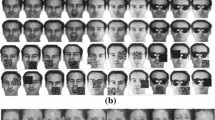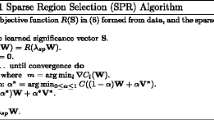Abstract
In this paper, we propose a new robust face recognition method through pixel selection. The method is based on the subspace assumption that a face can be represented by a linear combination in terms of the samples from the same subject. In order to obtain a reliable representation, only a subset of pixels with respect to smallest residuals are taken into the estimation. Outlying pixels which deviate from the linear model of the majority are removed using a robust estimation technique — least trimmed squares regression (LTS). By this method, the representation residual with each class is computed from only the clean data, which gives a more discriminant classification rule. The proposed algorithm provides a novel way to tackle the crucial occlusion problem in face recognition. Evaluation of the proposed algorithm is conducted on several public databases for the cases of both artificial and nature occlusions. The promising results show its efficacy.

Similar content being viewed by others
References
Basri R, Jacobs D (2003) Lambertian reflectance and linear subspaces. IEEE Trans Pattern Anal Mach Intell 25(2):218–233
Deng W, Hu J, Guo J (2012) Extended SRC: undersampled face recognition via intra-class variant dictionary. IEEE Trans Pattern Anal Mach Intell PP(99):1
Georghiades AS, Belhumeur PN, Kriegman DJ (2001) From few to many: illumination cone models for face recognition under variable lighting and pose. IEEE Trans Pattern Anal Mac. Intell 23(6):643–660
Hawkins DM, Olive DJ (1999) Improved feasible solution algorithms for high breakdown estimation. Comput Stat Data Anal 30(1):1–11
He X, Cai D, Niyogi P. (2005) Laplacian score for feature selection. In: Proc. of advances in neural information processing systems
Ho J, Yang MH, Lim J, Lee KC, Kriegman D (2003) Clustering appearances of objects under varying illumination conditions. In: Proc. IEEE int. conf. computer vision and pattern recognition, pp 11–18
Hong R, Wang M, Gao Y, Tao D, Li X, Wu X (2013) Image annotation by multiple-instance learning with discriminative feature mapping and selection. IEEE Trans Cybern 44(5):669–680
Hubert M, Rousseeuw PJ, Aelst Sv (2008) High-breakdown robust multivariate methods. Stat Sci 23(1):92–119
Lee K, Ho J, Kriegman D (2005) Acquiring linear subspaces for face recognition under variable lighting. IEEE Trans Pattern Anal Mach Intell 27 (5):684–698
Lee KC, Ho J, Kriegman D (2005) Acquiring linear subspaces for face recognition under variable lighting. IEEE Trans Pattern Anal Mach Intell 27(5):684–698
Martinez A, Benavente R (1998) The AR face database. CVC, Tech. Rep
Naseem I, Togneri R, Bennamoun M (2010) Linear regression for face recognition. IEEE Trans Pattern Anal Mach Intell 32 (11):2106–2112
Rousseeuw PJ (1984) Least median of squares regression. J Amer Stat Assoc 79(388)
Rousseeuw PJ, Driessen K (2006) Computing LTS regression for large data sets. Data Min Knowl Discov 12:29–45
Shen F, Shen C, van den Hengel A, Tang Z (2013) Approximate least trimmed sum of squares fitting and applications in image analysis. IEEE Trans Image Process 22(5):1836–1847
Shen F, Shen C, Hill R, van den Hengel A, Tang Z (2014) Fast approximate l ∞ minimization: speeding up robust regression. Comput Stat Data Anal 77(0):25–37
Shen F, Shen C, Shi Q, van den Hengel A, Tang Z (2013) Inductive hashing on manifolds In: IEEE conference on computer vision and pattern recognition (CVPR’13)
Shen F, Tang Z, Xu J (2013) Locality constrained representation based classification with spatial pyramid patches. Neurocomputing 101(0):104–115
Shi Q, Eriksson A, van den Hengel A, Shen C (2011) Is face recognition really a compressive sensing problem?. In: Proc. IEEE int. conf. computer vision and pattern recognition, pp 553–560
Sim T, Baker S, Bsat M (2003) The CMU pose, illumination, and expression database. IEEE Trans Patt Anal Mach Intell 25:1615–1618
Wang M, Hua XS, Hong R, Tang J, Qi GJ, Song Y (2009) Unified video annotation via multigraph learning. IEEE Trans Circ Syst Video Technol 19(5):733–746
Wang M, Hua XS, Tang J, Hong R (2009) Beyond distance measurement: constructing neighborhood similarity for video annotation. IEEE Trans Multimedia 11(3):465–476
Wang M, Ni B, Hua XS, Chua TS (2012) Assistive tagging: a survey of multimedia tagging with human-computer joint exploration. ACM Comput Surveys 44(4):25
Wright J, Yang AY, Ganesh A, Sastry SS, Ma Y (2009) Robust face recognition via sparse representation. IEEE Trans Pattern Anal Mach Intell 31:210–227
Yang Y, Huang Z, Shen HT, Zhou X (2011) Mining multi-tag association for image tagging. World Wide Web 14(2):133–156
Yang Y, Huang Z, Yang Y, Liu J, Shen HT, Luo J (2013) Local image tagging via graph regularized joint group sparsity. Pattern Recog 46(5):1358–1368
Yang Y, Yang Y, Huang Z, Shen HT, Nie F (2011) Tag localization with spatial correlations and joint group sparsity. In: IEEE conference on computer vision and pattern recognition, pp 881–888. IEEE
Yang Y, Yang Y, Shen HT (2013) Effective transfer tagging from image to video. ACM Trans Multimedia Comput Commun Appl 9(2):14:1–14:20
Yang Y, Yang Y, Shen HT, Zhang Y, Du X, Zhou X (2013) Discriminative nonnegative spectral clustering with out-of-sample extension. IEEE Trans Knowl Data Eng 25(8):1760–1771
Yang Y, Zha ZJ, Gao Y, Zhu X, Chua TS (2014) Exploiting web images for semantic video indexing via robust sample-specific loss. IEEE Trans Multimedia 16(6):1677–1689
Zhang L, Gao Y, Hong C, Feng Y, Zhu J, Cai D (2013) Feature correlation hypergraph: exploiting high-order potentials for multimodal recognition. IEEE Trans Cybern 44(8):1408–1419
Zhang L, Gao Y, Lu K, Shen J, Ji R (2014) Representative discovery of structure cues for weakly-supervised image segmentation. IEEE Trans Multimedia 16(2):470–479
Zhang L, Gao Y, Xia Y, Dai Q, Li X (2014) A fine-grained image categorization system by cellet-encoded spatial pyramid modeling. IEEE Trans Ind Electron:1
Zhang L, Han Y, Yang Y, Song M, Yan S, Tian Q (2013) Discovering discriminative graphlets for aerial image categories recognition. IEEE Trans Image Process 22(12):5071–5084
Zhang L, Song M, Liu X, Bu J, Chen C (2013) Fast multi-view segment graph kernel for object classification. Signal Process 93(6):1597–1607
Zhang L, Song M, Liu X, Sun L, Chen C, Bu J (2014) Recognizing architecture styles by hierarchical sparse coding of blocklets. Inf Sci 254:141–154
Zhang L, Yang M, Feng X (2011) Sparse representation or collaborative representation: which helps face recognition? In: Proc. IEEE int. conf. computer vision, pp 471–478
Zhang L, Yang Y, Gao Y, Yu Y, Wang C, Li X (2014) A probabilistic associative model for segmenting weakly-supervised images. IEEE Trans Image Process 23(9):4150–4159
Acknowledgments
Wankou Yang was supported by NSFC under project No.61375001.
Author information
Authors and Affiliations
Corresponding author
Rights and permissions
About this article
Cite this article
Shen, F., Yang, W., Li, H. et al. Robust regression based face recognition with fast outlier removal. Multimed Tools Appl 75, 12535–12546 (2016). https://doi.org/10.1007/s11042-014-2340-4
Received:
Revised:
Accepted:
Published:
Issue Date:
DOI: https://doi.org/10.1007/s11042-014-2340-4




